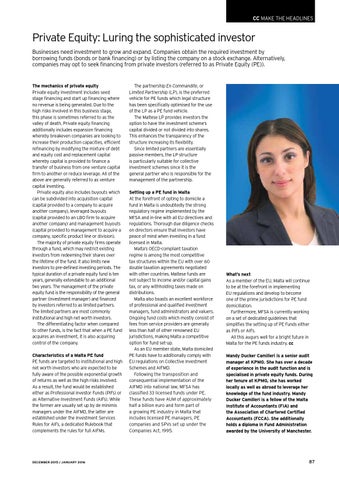CC make the headlines
Private Equity: Luring the sophisticated investor Businesses need investment to grow and expand. Companies obtain the required investment by borrowing funds (bonds or bank financing) or by listing the company on a stock exchange. Alternatively, companies may opt to seek financing from private investors (referred to as Private Equity (PE)).
The mechanics of private equity Private equity investment includes seed stage financing and start up financing where no revenue is being generated. Due to the high risks involved in this business stage, this phase is sometimes referred to as the valley of death. Private equity financing additionally includes expansion financing whereby breakeven companies are looking to increase their production capacities, efficient refinancing by modifying the mixture of debt and equity cost and replacement capital whereby capital is provided to finance a transfer of business from one venture capital firm to another or reduce leverage. All of the above are generally referred to as venture capital investing. Private equity also includes buyouts which can be subdivided into acquisition capital (capital provided to a company to acquire another company), leveraged buyouts (capital provided to an LBO firm to acquire another company) and management buyouts (capital provided to management to acquire a company, specific product line or division). The majority of private equity firms operate through a fund, which may restrict existing investors from redeeming their shares over the lifetime of the fund. It also limits new investors to pre-defined investing periods. The typical duration of a private equity fund is ten years, generally extendable to an additional two years. The management of the private equity fund is the responsibility of the general partner (investment manager) and financed by investors referred to as limited partners. The limited partners are most commonly institutional and high net worth investors. The differentiating factor when compared to other funds, is the fact that when a PE fund acquires an investment, it is also acquiring control of the company. Characteristics of a Malta PE fund PE funds are targeted to institutional and high net worth investors who are expected to be fully aware of the possible exponential growth of returns as well as the high risks involved. As a result, the fund would be established either as Professional Investor Funds (PIFs) or as Alternative Investment Funds (AIFs). While the former are usually set up by de minimis managers under the AIFMD, the latter are established under the Investment Services Rules for AIFs, a dedicated Rulebook that complements the rules for full AIFMs.
DECEMBER 2015 / JANUARY 2016
The partnership En Commandite, or Limited Partnership (LP), is the preferred vehicle for PE funds which legal structure has been specifically optimised for the use of the LP as a PE fund vehicle. The Maltese LP provides investors the option to have the investment scheme’s capital divided or not divided into shares. This enhances the transparency of the structure increasing its flexibility. Since limited partners are essentially passive members, the LP structure is particularly suitable for collective investment schemes since it is the general partner who is responsible for the management of the partnership. Setting up a PE fund in Malta At the forefront of opting to domicile a fund in Malta is undoubtedly the strong regulatory regime implemented by the MFSA and in-line with all EU directives and regulations. Thorough due diligence checks on directors ensure that investors have peace of mind when investing in a fund licensed in Malta. Malta’s OECD-compliant taxation regime is among the most competitive tax structures within the EU with over 60 double taxation agreements negotiated with other countries. Maltese funds are not subject to income and/or capital gains tax, or any withholding taxes made on distributions. Malta also boasts an excellent workforce of professional and qualified investment managers, fund administrators and valuers. Ongoing fund costs which mostly consist of fees from service providers are generally less than half of other renowned EU jurisdictions, making Malta a competitive option for fund set-up. As an EU member state, Malta domiciled PE funds have to additionally comply with EU regulations on Collective Investment Schemes and AIFMD. Following the transposition and consequential implementation of the AIFMD into national law, MFSA has classified 33 licensed funds under PE. These funds have AUM of approximately half a billion euro and form part of a growing PE industry in Malta that includes licensed PE managers, PE companies and SPVs set up under the Companies Act, 1995.
What’s next As a member of the EU, Malta will continue to be at the forefront in implementing EU regulations and develop to become one of the prime jurisdictions for PE fund domiciliation. Furthermore, MFSA is currently working on a set of dedicated guidelines that simplifies the setting up of PE Funds either as PIFs or AIFs. All this augurs well for a bright future in Malta for the PE funds industry. cc Mandy Ducker Camilleri is a senior audit manager at KPMG. She has over a decade of experience in the audit function and is specialised in private equity funds. During her tenure at KPMG, she has worked locally as well as abroad to leverage her knowledge of the fund industry. Mandy Ducker Camilleri is a fellow of the Malta Institute of Accountants (FIA) and the Association of Chartered Certified Accountants (FCCA). She additionally holds a diploma in Fund Administration awarded by the University of Manchester.
87
